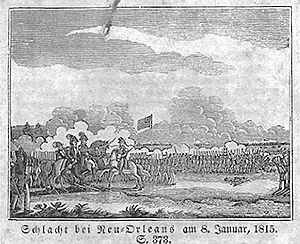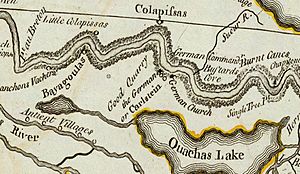German Coast facts for kids
The German Coast (French: Côte des Allemands, Spanish: Costa Alemana, German: Deutsche Küste) was a region of early Louisiana settlement located above New Orleans, and on the west bank of the Mississippi River. Specifically, from east (or south) to west (or north), in St. Charles, St. John the Baptist, and St. James parishes of present-day Acadiana. It was largely settled by German immigrants. The four slave-holding plantations that they developed along this "coast" were Karlstein, Hoffen, Mariental, and Augsburg.
The Whitney Plantation opened for tours in 2014 in the German Coast. It is a slavery museum that is open to the public.
Settlements
About 4,000 Germans from the Rhine valley were recruited in early spring of 1720, but many of them perished due to harsh conditions on their long journey to the Louisiana wilderness and just a few hundred finally arrived at their new home. In March 1722, a Company official counted 330 settlers.
Karlstein was the collective name of the German colonial villages that opened the River Parishes to European colonization. Karlstein was named for Karl Friedrich d’Arensbourg who, for more than 55 years, was the acknowledged leader of the German settlers in the region along the west bank of the Mississippi River extending roughly from Taft north to Lucy in present-day Louisiana. By 1723, the area included several dozen homes, contained in the settlement of Hoffen (later Glendale, Hymelia, Trinity, and Killona plantations), Augsberg (to the rear of Killona and Waterford Plantations) and Mariental (behind the present site of Agrico and OxyChem industrial plants at Taft).
The area's name was derived from the large population of German immigrants who were settled along the Mississippi River in 1721, led by Charles Frederick d'Arensbourg, who was working for the Company of the Indies. When the company folded in 1731, the Germans became independent land owners.
Despite periodic flooding, hurricanes, and the rigors of frontier life, the German pioneers made a success of their settlements. Their farming endeavors provided food not only for themselves but also for New Orleans' residents. Some historians credit these German farmers with the survival of early New Orleans.
Between 1769 and 1777, Governor Luis de Unzaga Amezaga 'le Conciliateur' promoted the colonization of the extensive province of Louisiana and distributed land and agricultural tools to the European families who came to live there. Unzaga created the world's first bilingual public educational system in New Orleans and also allowed various peoples to continue speaking in various languages such as English on the eastern bank of the Mississippi or German on the so-called German coast.
Culture
Most of the German Coast settlers came from the Rhineland region of Germany, the German-speaking cantons of Switzerland, and other areas. Many came from the German-speaking region of Alsace-Lorraine in France, and some from Belgium.
From the time of their arrival, the German immigrants began speaking French and intermarried with the early French settlers. Over the subsequent decades they intermarried with the descendants of the latter as well as the Acadians, (Acadians are those who became known as "Cajuns.")
A number of common Cajun surnames have German origins: for example, Schexnayder (various spellings), LaBranche (a calque of Zweig), Folse, Zeringue (Zehring), Hymel (Himmel), and Trosclair (a phonetic macaronic of Troxler).
Military participation

In the Louisiana Rebellion of 1768, German colonists joined with Acadians from the Cabannocé Post area to march on New Orleans and overthrow the new Spanish colonial governor Antonio de Ulloa.
A few years later, the German and Acadian settlers united again, under Spanish colonial governor Bernardo de Gálvez, to fight the British during the American Revolutionary War.
1811 slave uprising
The German Coast was the site of the largest slave revolt in US history, the 1811 German Coast Uprising. This was after the US had acquired the Louisiana Territory. It was more than a year before the Territory of Orleans was admitted as the state of Louisiana.
The rebellion's leaders were slaves Quamana and Harry, and Charles Deslondes, a free man of color. They gathered an estimated 500 slaves from plantations along the River Road and marched toward New Orleans. The insurgents killed two white men without meeting much resistance, but they were not well armed.
The local militia was called out and killed nearly half of the total ninety-five slaves who died as a result of the rebellion. The remainder were executed after tribunals were held in the parishes, including Orleans Parish.
World War I
During World War I, in a reaction against Germany as the enemy, the Louisiana state legislature passed Act 114: it prohibited all expressions of German culture and heritage in the state, especially the printed or spoken use of the German language. The use of the German language had declined among descendants of settlers of the German coast, but descendants of more recent German immigrants who arrived after the Revolutions of 1848 and later were affected.
See also
 In Spanish: Costa Alemana para niños
In Spanish: Costa Alemana para niños


